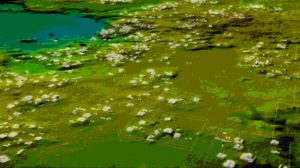 2
2

Product quality: deliberate "cartridges"
 02. 05. 2024
02. 05. 2024



 2
2

 02. 05. 2024
02. 05. 2024
 1
1

 01. 05. 2024
01. 05. 2024

 30. 04. 2024
30. 04. 2024

 14. 02. 2018
14. 02. 2018

In recent days, it has been conducted by world news agencies report on new discoveries in the Guatemalan jungle. The researchers used a technology called LIDAR (Light Imaging Detection and Ranging), in which objects hidden under treetops are made visible by pulses of laser beams, usually emitted from drones or planes reflected from the earth's surface. Digitally, the trees in the uninhabited landscape were removed and the contours of ancient Mayan buildings appeared. In Guatemala, an area of about 2100 km was explored2. PACUNAM, which conducts the survey, wants to map a total of about 14000 km2.
According to scientists, the use of this technology is the greatest benefit for the 150 years of Mayan archeology. Laser mapping thus enabled the discovery of thousands of stone objects in the Peten region, near the Mayan city of Tikal, which confirm that the civilization of that time was at the level of the civilizations of China or Greece 1.200 years ago. Scientific studies show that up to 10 million people could live in this area in the necessary technically and agriculturally equipped infrastructure, where up to 95% of the available space was used to grow crops., said Francisco Estrada Belli, an assistant professor at the University of Tulane. In his opinion, thousands of Mayan settlements can be hidden in the locality, on a total area of up to 14.000 km2.
 Extensive ramparts, roads, and irrigation canals are evidence of a thoughtful organization of labor in the Mayan civilization. In other ancient civilizations, these engineering structures were destroyed by generations of successors, the Mayan buildings were apparently abandoned and preserved in the jungle. The use of LIDAR technology thus gives archaeologists new detailed information that they were not previously able to reveal during ground surveys.
Extensive ramparts, roads, and irrigation canals are evidence of a thoughtful organization of labor in the Mayan civilization. In other ancient civilizations, these engineering structures were destroyed by generations of successors, the Mayan buildings were apparently abandoned and preserved in the jungle. The use of LIDAR technology thus gives archaeologists new detailed information that they were not previously able to reveal during ground surveys.
The Mayan civilization, which was at the height of its development about 1500 years ago, covered an area about twice the size of medieval England, with an originally estimated population of about five million people, which, according to current research, can be estimated at 10 to 15 million people. Most of the 60 newly discovered structures are considered stone foundations on which Mayan houses were built. One of the hidden objects was a seven-storey pyramid. Archaeologists were also surprised by the network of roads connecting all the Mayan cities in the area, where the elevated roads allowed passage even during the rainy season.